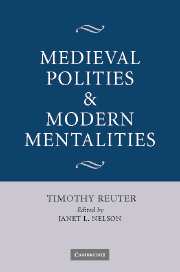Book contents
- Frontmatter
- Contents
- Editor's note
- Acknowledgements
- List of abbreviations
- Editor's introduction
- PART I MODERN MENTALITIES: HISTORIOGRAPHIES, METHODOLOGIES, PRECONCEPTIONS
- 1 Modern mentalities and medieval polities
- 2 Medieval: another tyrannous construct?
- 3 The insecurity of travel in the early and high Middle Ages: criminals, victims and their medieval and modern observers
- 4 Debating the ‘feudal revolution’
- 5 Pre-Gregorian mentalities
- 6 Whose race, whose ethnicity? Recent medievalists' discussions of identity
- PART II THE SYMBOLIC LANGUAGE OF MEDIEVAL POLITICAL ACTION
- PART III POLITICAL STRUCTURES AND INTENTIONS
- Index
4 - Debating the ‘feudal revolution’
Published online by Cambridge University Press: 12 August 2009
- Frontmatter
- Contents
- Editor's note
- Acknowledgements
- List of abbreviations
- Editor's introduction
- PART I MODERN MENTALITIES: HISTORIOGRAPHIES, METHODOLOGIES, PRECONCEPTIONS
- 1 Modern mentalities and medieval polities
- 2 Medieval: another tyrannous construct?
- 3 The insecurity of travel in the early and high Middle Ages: criminals, victims and their medieval and modern observers
- 4 Debating the ‘feudal revolution’
- 5 Pre-Gregorian mentalities
- 6 Whose race, whose ethnicity? Recent medievalists' discussions of identity
- PART II THE SYMBOLIC LANGUAGE OF MEDIEVAL POLITICAL ACTION
- PART III POLITICAL STRUCTURES AND INTENTIONS
- Index
Summary
The ‘feudal revolution’ has become conventional shorthand for the disappearance, around the millennium, of a ‘centre’ able to control the localities, and the appropriation by those bent on local dominance of the shell of legitimate authority which this process left behind. The combination of this with shifts in structures of family and settlement yielded encellulement, which was rather more than Italian incastellamento writ large: at a political and cultural level it means the dominance of small-scale forms of organization with very little set over them by way of more overarching forms of rule or community. Discussions of the ‘feudal revolution’ originally stressed changes at fundamental levels of social and political organization, but T. N. Bisson's reconsideration underlines the accompanying changes in mentalities, especially in relation to the social role of violence. The contrast as he depicts it is not a simple one between peace before and violence after the millennium, but between an older violence whose primary role was the maintaining of public order and a newer ‘private’ violence practised by the masters of castles and their followers. This was ‘personal, affective, but inhumane; militant, aggressive, but unconstructive’. Unconstructive or not, Bisson depicts lords and their armed gangs as holding something like an ideology of violence, as seen both in the sparse narrative sources of the period and in the language used by charters. Lordship was not only in fact predatory, as no doubt it had always been and would long remain, but it also consciously saw itself as such.
- Type
- Chapter
- Information
- Medieval Polities and Modern Mentalities , pp. 72 - 88Publisher: Cambridge University PressPrint publication year: 2006

